Position: How Tos - Partition Management - How to Restore USB Drive Back to Full Capacity?
DiskGenius - An effective tool to recover files from corrupted/unreadable hard drives, USB flash drives, pen drives, memory cards and virtual disks.
ô Free DownloadQuick Navigation:
It can be frustrating when you are unable to use the full storage capacity of your USB drive due to various reasons. Nowadays, USB storage devices such as external hard drives, USB flash drives, pen drives, and memory cards play an important role in our daily lives. These devices come in different sizes, ranging from 215 MB to 1TB, and enable us to store large amounts of data, which we can take with us anywhere without any difficulty. However, sometimes an issue arises where a 64GB flash drive shows as only 54MB. In such cases, it may not always be necessary to buy a new one. The capacity can often be restored with a few simple steps.
Let's take a close look at a real cause about this issue:
"Lately I made a bootable USB drive on a USB flash drive for crashed laptop. I fixed the system problem successfully but a new problem arose in the flash drive. The problem is that the USB's capacity shrank. The flash drive used to have 16GB storages, but it is 2.19MB in Windows Explorer only after it is made as a bootable drive. There is large free space on the flash disk when I checked it in Disk Management. But I can't do anything to unallocated space. The size does not change even though I format the partition. Do you have any idea to restore capacity? Thanks!"
USB flash drive / SD card/ pen drive not showing full capacity can happen for several reasons. Let's see some common reasons together:
This part provides three solutions to restore USB drive backup to original capacity. The first method recovers capacity with the help of command DiskPart. If you feel this approach is difficult to you, you can try the second and third solutions which utilize a free third-part tool. Connect the USB drive or SD card to computer and you can try these resolutions.
Caution: The first two solutions will completely wipe the entire USB drive in question, please backup any important files before proceeding. Besides, please be very careful to select correct before formatting or cleaning operations, or you might wipe wrong disk by mistake.
Step 1. Run Command Prompt as Administrator. On Windows 8.1 or 10, you can launch it easily by clicking the Start button and selecting option Command Prompt (Admin). If you are using Windows 7, you should click the Start button and enter cmd in the search box; then right-click cmd.exe to select Run as Administrator
Step 2. Type the following command in the Command Prompt windows and hit Enter key.
diskpart
Step 3. Type list disk command so that diskpart lists all disks connected to your computer, and the command should be followed by pressing Enter.
list disk
Step 4. Execute following command to select the USB disk you want to restore capacity.
select disk #
Step 5. Type the follow command and press Enter.
clean
Step 6. Create a new partition on the USB drive after DiskPart succeeded in cleaning the disk.
create partition primary
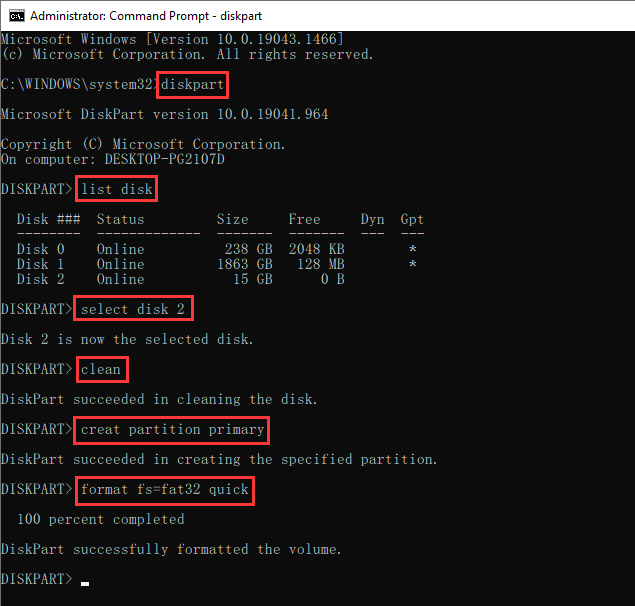
Step 7. The following command formats the newly created partition to FAT32 file system.
format fs=fat32 quick
Now you can open Windows Explorer to check if the USB drive is restored to full capacity.
This solution will repartition the USB drive into one partition using free partition management software DiskGenius Free. The partition process is simple and fast.
Step 1. Install and launch DiskGenius on your computer to get the main interface.
Step 2. Connect the USB drive to computer and it'll be displayed in the software. All disks, partitions, files and disk parameters on the computer can be read on the main interface.
Step 3. Select the USB drive you want to restore capacity and click "Quick Partition" button from the toolbar.
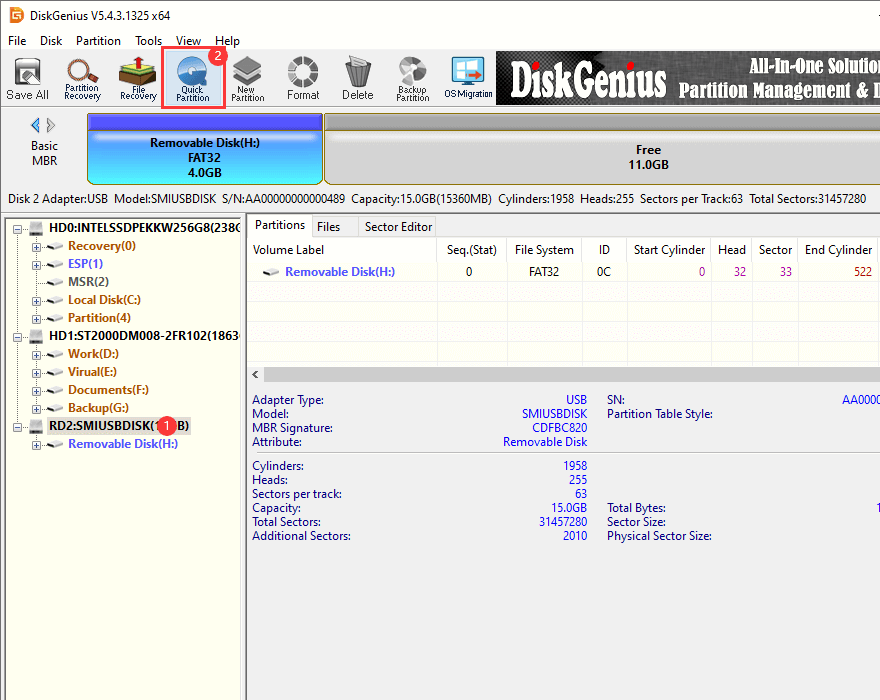
Step 4. On the "Partition Count" section, you should select Custom option and choose "1" so that there will be only one partition on the USB drive; As to the Advanced Options, you can choose file system format for the USB disk. Click OK button and DiskGenius start repartition the USB drive.
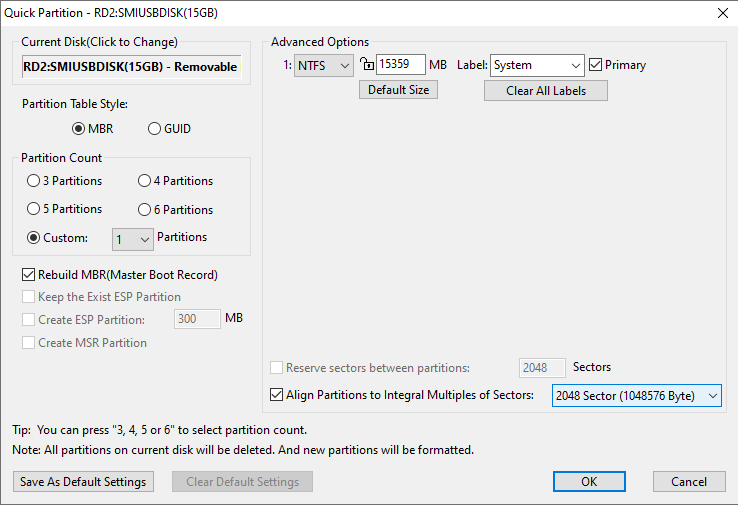
Step 5. DiskGenius will ask confirmation for the action which will wipe everything on the disk while repartitioning process. Click "Yes", wait for a couple of seconds, and the partition will complete.
The USB flash drive will show its full capacity in Windows Explorer after it is repartitioned to single volume. Another way to recover capacity is deleting all partitions on the UDB disk and then creating a new partition on it.
If your USB drive contains unallocated / free space, its size will be smaller than original capacity. In this situation, you can recover USB capacity by adding unallocated space to partition . It's recommended to use DiskGenius here again, as this software is able to add unallocated space to any existing partition on same disk without data loss.
Step 1. Launch DiskGenius again and connect the problematic USB drive to computer.
Step 2. Right click the partition on the USB flash disk and select "Extend Partition" from the context menu.
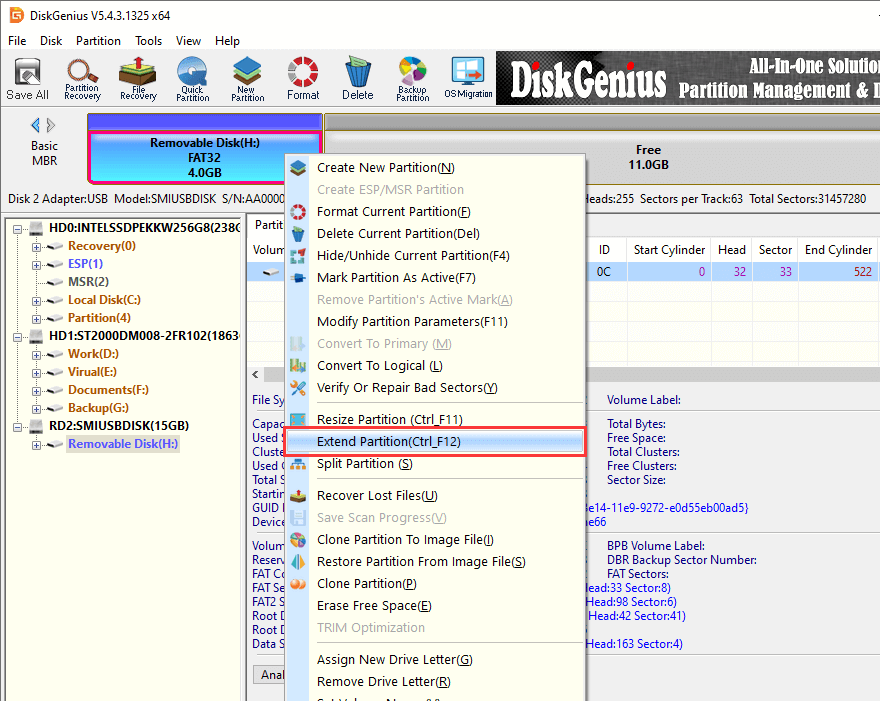
Step 3. Move mouse to the partition bar and drag it to include the free disk space. Click "Start" button and DiskGenius starts move unallocated disk space to the partition.
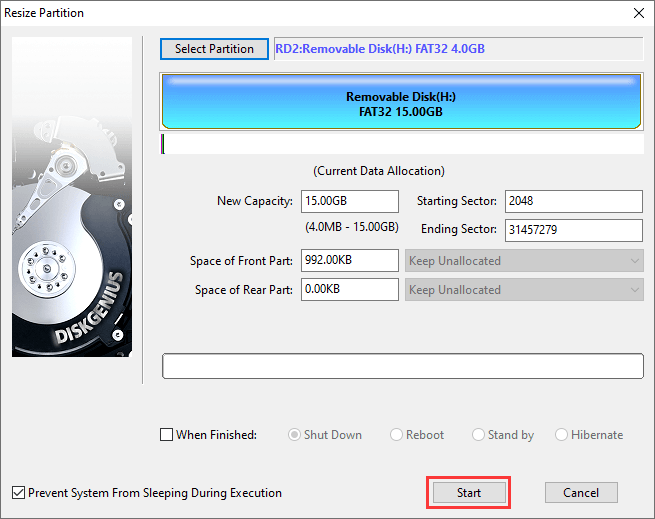
Step 4. Click "Complete" button when the process finishes. Then you can check whether the capacity is restored.
To restore the capacity, there is a solution. The unallocated space on the drive needs to be deleted, and the flash drive should be reformatted. To do this, follow these steps:
Step 1. Open the Disk Management window by right-clicking "This PC" and selecting "Manage." Click "Disk Management" under the "Storage" section.
Step 2. Right-click on the flash drive and select "Delete volume." Confirm the action by clicking "Yes".
Step 3. Once done, right-click again on the flash drive and select "New Simple Volume".
Step 4. Follow the prompts to format the flash drive with the desired file system (NTFS, FAT32, etc.).
By following these steps, the full capacity of the USB drive should be restored.
In summary, there are various methods available to restore the full capacity of a USB drive. Firstly, formatting the USB drive can clear old data, eliminate partitions or unallocated space. Secondly, using disk management tools to reset drives can solve some firmware issues. In addition, updating the firmware or upgrading the driver of the USB drive can solve many other problems. Regardless of the method used, it is recommended to back up all data before processing USB drives to avoid accidental data loss.
DiskGenius - Free disk partition software to format/reformat/repartition/resize USB flash drives, and check & repair bad sectors for hard drives and USB drives.
ô Free Download